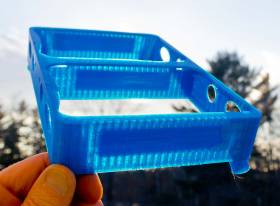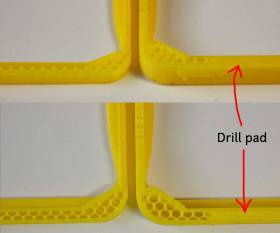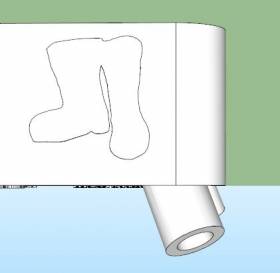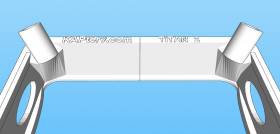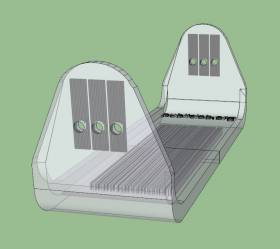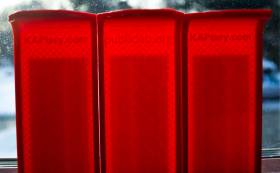Inside a Titan
The 3D model for the Titan 2 camera tray is the most complex model I have made. It's a rather big rig for kite aerial photography, but the job it has to do is straightforward: 1) hold two cameras pointed in the same direction, 2) be strong and rigid yet lightweight, 3) allow easily detachable legs, 4) allow the tray to be either tilted or horizontal, and 5) allow easy, balanced attachment to a frame. The real challenge was to make such a model that would be easy to print on a small 3D printer.
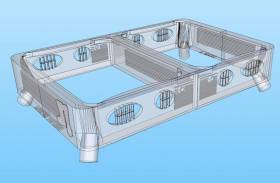 |
| The Titan 2 Rig tray has seven areas of internal structure which print more solid than the rest of the part. The oval windows have removable grids of support so their ceilings are smoother. |
The constraints imposed by 3D printing are myriad. Printing is slow, especially if parts are solid. So parts are typically mostly air with a network of plastic strands or plates. That affects strength, so the proper combination of part thickness and fill is needed. If bolts will connect parts together, that area of the part has to be solid enough so it will resist compression. The Titan 2 Rig tray has seven areas where bolts might be tightened, and each has to be more solid than the rest of the tray. These areas have thin plates inside the walls of the 3D model which slicing programs try to recreate in their instructions to the printer for where to put plastic. The largest of these areas are on the camera platforms where holes for a tripod bolt must be drilled. This hole could be anywhere, so most of the platform is a more or less solid drilling pad.
The 20 second video above has no audio.
Size is a constraint with the Titan 2 tray because the build platform of a MakerBot Replicator 1 is just big enough for a tray that can hold two point & shoot cameras. I wanted the leg brackets at the corners of the tray to angle outwards so the legs did not get photographed, but that caused them to exceed the horizontal limits of the build area. So the brackets had to be tucked inwards so they could angle outwards, and that required building special supporting structures without impinging too much on the cameras' space.
To make it easy to print a part, it’s really nice if there are no overhangs that require support. FDM (fused deposition modeling) printers have to build the part bottom-to-top and can deposit plastic only on top of other plastic. Slicing programs decide where temporary structures have to be built alongside the part to support overhangs, but these require more time, can fail, and sometimes are messy to remove. The Titan 2 tray was designed so it will print without support. That required some compromises, but it makes it possible for more people to print their own easily. The big oval windows are marginal for printing with no support, so I added a thin grid inside them. This ensures that the ovals don’t sag and the thin plastic is easy to remove. But it was too thin for my primary slicing program, Simplify3D, to deal with. Coincidentally, that program also choked on other aspects of the model, so I could only slice it in MakerWare. It’s the only KAPtery part that I don’t slice in Simplify3D.

